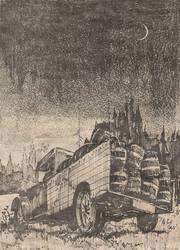Heaviest use: 1920 – 1933
The prohibition of beverage alcohol in the early 1900s paved the way for one of the area's most colourful chapters of thrill and intrigue.
Alcohol Prohibition
The prohibition in Canada lasted for eight years, 1916 to 1924, and in the United States from 1920 until 1933. During the four years of overlap, private “moonshine” distilleries were not uncommon in the basements of Turtle Mountain homesteads both for personal and commercial use. Local entrepreneurs could make good money by distilling their own alcohol and selling it on the black market—money that they used, more often than not, to clothe their children and buy essentials.
At the time the Dunseith trail was the highway from Dunseith, North Dakota all the way up to Brandon, Manitoba. It was not a highway as we might picture today – perfectly tarred, flat and straight – but little more than a trail winding through the bush and hills covering Turtle Mountain. Manitoba Highway 10 was eventually built to accomplish much the same thing, but for a different age.

Rum-Running to the U.S.A.
When Canadian prohibition was lifted in 1924 and the government allowed the controlled sale of liquor, activity over the border picked up as rum-runners found there was wealth to be made in the sale of legally purchased Canadian rum to the Americans. There wasn't a customs office on the border until the 1950s; offices for immigration being housed in Boissevain and Dunseith. Therefore it was almost the easiest thing in the world to slip across the line and meet at a rendezvous. The Kelvin Clinic south of the border was a popular drop-off point, though the building was moved a mile east of its original location when North Dakota Highway 281 went through the area.
Most of the booze was smuggled along the Dunseith Trail hidden in loads of grain or baled hay. Another method of smuggling was by packhorse. The animals were so well trained that they would follow behind a horse and rider without a lead or halter and would run homeward at a signal from the rum-runner if he was intercepted or felt that interception was likely. The horse laden with damning evidence would promptly return home and the rum-runner could not be proven guilty. People did get caught, but the jail sentence was no more than six months.
The Thrill of the Chase!
The most daring young men loaded their automobiles full of rum, the value of each load easily reaching $10,000. They would use the daylight hours for transport and go armed with a fake licence plate and drivers licence, so in the event of getting caught, there would be no ID whatsoever in the vehicle. A model of car called the Hudson Super Six was faster than anything the RCMP had and was a favorite among rum-runners. So was the Model T Ford. These vehicles had big and durable tires, perfect for gaining purchase on the muddy or slippery bush trail.
The rum-runner's existence was an exciting and exhilarating one. The men involved – often young men with energy to burn – had to be sneaky, crafty, and able to think quickly in order to evade law enforcement and a possible jail sentence. Their operations became so well organised that their successes became an embarrassment to the authorities of the area. (Yet there are stories of police and customs officers being involved in the smuggling operations.)
Rum-running days came to an end largely due to improved roads and increased mobility of the law enforcement officers. Also, in 1934 the American prohibition of alcohol was lifted. Demand diminished, then dried up completely.
. . . . .
Related Articles:
. . . . .
Author: Teyana Neufeld
Sources:
Baskerville, Barry. Personal Interview. 13 Aug. 2008.
Beckoning Hills Book Committee. Beckoning Hills “Dawn of New Millennium” Boissevain—Morton 1981—2006. Brandon: Leech Printing Ltd., 2006.
Moncur, William and Anna Grace Diehl. “Whitewater Settlement Tour.” Bill Moncur Box 1 Series 1-4 MG14 / C164. Boissevain Community Archives.
Ransom, Gerry. Personal Interview. 13 Aug. 2008.
